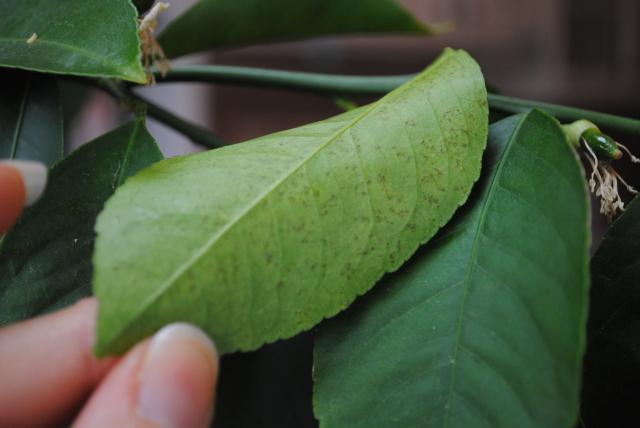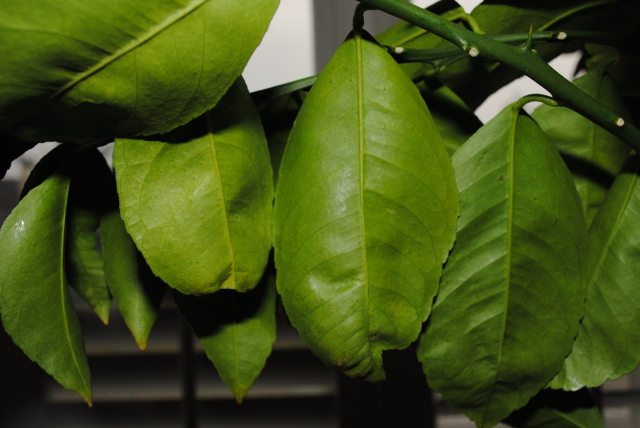Question Underside of Leaf
Underside of Leaf
QUESTION: I have a dwarf meyer lemon tree which I purchased about a year ago. It is potted in a large pot with drainage stones in the bottom. I followed the growers specifications for soil and potting. It seemed to do well outside during the summer on my patio with a southern exposure. We live in NJ so I brought it indoors when the weather started to get too cool. I placed it in our kitchen surrounded by windows with the same southern exposure. Not long after bringing it in, the leaves toward the inside of the tree started to turn yellow and drop off. After a while I noticed some webbing and treated it with 2 applications (about 1.5 weeks apart)of Safer Insecticidal Soap assuming it had a mite infestation. I have been watching it closely and every now and then I find a small amount of webbing or a live mite. (assuming they are mites) The webbing is usually along the branches or within clusters of flowers and fruit. Since it has to remain indoors until spring and I have children and a pet bird I can not spray harsh chemicals right now. So I have been wiping the plant down with wet napkins or wipes by hand to remove the webs and any evidence of mites. This is very time consuming but seems to be keeping them under control but obviously has not eliminated them.
Now I have noticed a possible new problem. There are small brownish slightly raised bumps (like a brown heat rash) on the underside of the leaves. The brown does not currently show through to the top side of the leaves however from the top side the leaves appear as if they have yellowish or light green spots. If you hold the leaves up to the light, the light goes through the spots making them more easily seen. The leaves also look a little dry and wilted and the tips of a few are turning brown. A number of leaves are misshapen. The plant had a lot of flowers which produced many tiny lemons but most fall off before they are larger than a pea. Many take on a slight yellow tinge before falling off. There are a few that are a about the size of a quarter but at the rate they are growing I'm not sure they will ever get to full size and ripen.
I would like to know what the brown infection is on the leaves and how best to treat it safely. I did some research and did not find an identical image however it looks a bit like citrus scab but much milder than the photos I saw on the net. The brown is not currently on the top of the leaves but only on the underside. It also looks somewhat like greasy spot. I'm sure there are other problems it is similar to as well, which is why I need an expert to identify it. I will try to attach a photo. I took several photos I can e-mail you if you tell me where to send them. I'm not sure it will let me attach more than one here. Thanks for your help!
ANSWER: Hi Karen,,
It sounds like your lemon tree is receiving lots of love and care which is wonderful. The symptoms that you observe on the leaves are most likely edema (oedema). This commonly occurs on indoor plants during the winter months. It occurs because the plants are not actively growing in the winter and therefore, they are not using much water. When the roots are in wet and cool soil, they will continue to absorb water and nutrients which is sent to the leaves. The cells and the leaves become so plump with water that they actually explode. The result is edema which first begins as water soaking and then develops into brownish, slightly raised spots on the leaves. The damage is generally on the undersides of the leaves, but if severe you may find it on both upper and lower surfaces. To correct the problem, stop watering the plant and allow the soil to dry out. You also mentioned that the leaves appeared a bit wilted and misshapen. Sometimes too much water in the leaves will actually cause them to appear wilted. The leaves that are misshapen may actually be due to the mite problem.
Spider mites are a common problem on house plants since they like the dry air. It sounds like you are doing a good job monitoring the plant and removing mites when you see them. It might be time for another treatment. In addition to using insecticidal soap, you can also treat house plants with horticultural oil which is available in garden centers. If you have additional house plants, you should treat them at the same time because the mites may be hiding on these other plants and them move over to your lemon plant after treatment.
Now to address the problem with the fruit falling off prior to maturity. The problem sounds like the flowers are not getting pollinated. If you only have one lemon tree, you really need at least one more if you desire fruit. Lemon trees are more likely to produce fruits if they are pollinated by another tree (cross pollinated) then if they must self pollinate.
If you decide to get a second tree, assuming your plant is back outside in the summer, monitor for insect activity. Most lemon flowers are fertilized by insects (ie bees). If you do not observe bee activity at your flowers or if your plant is inside during the flower period, you may have to help things along. There is an eHow article that explains how to do this:
http://www.ehow.com/how_8041074_pollinate-lemon-trees.html
Good luck with your plant!
--Jen
---------- FOLLOW-UP ----------
 Close Up Leaves #2
Close Up Leaves #2
QUESTION: Hi Jen! Thanks for your quick response. I am relieved to know that the problem with the leaves may not be a virus, fungus or bacteria. I did want to let you know that I do not water my tree more than once a week indoors and I try to let it dry completely in between waterings. It usually looks extra droopy before I water and then perks up afterward. I fertilize once a month. I also spray the tree with tap water occasionally a couple of times a week. Do you still think that the problems I am having could be from the plant getting too much water? Is it bad to spray the leaves with water if the edema is caused by too much water? Also is horticultural oil non toxic and safe for kids, pets and fruit? Are there any particular sprays you recommend for mites. I have seen ads for products containing neem or other natural plant based oils which claim to control mites. Something like this would allow me to treat the plant indoors during the cold months. Attached another photo in case it is helpful. Thanks again for all the advice. You have been a big help.
AnswerIt is probably not necessary to spray the leaves with tap water unless you are trying to wash the leaves to remove dust or insects. Plants take up very little water through the leaf surface and other problems such as fungal or bacterial pathogens can actually spread by wetting the leaves. I would not do this unless you need to clean the plant or remove mites.
Edema occurs when the soil is wet and the plant is not transpiring enough to use up all the water sent to the leaves. You might want to review this link which explains the problem:
http://www.coopext.colostate.edu/TRA/PLANTS/edema.shtml
Horticultural oils such as neem oil are non-toxic and safe to use around pets and kids. Actually, some formulations of neem oil are used on itchy dogs to help get rid of mites that are bothering them. You can purchase a product or you can actually find recipes on the internet for homemade horticultural oils and insecticidal soaps that use products that you probably have in your kitchen. Just search for homemade horticultural oil. If you make something homemade, I suggest that you tag a few of the leaves and spray the product on them. Then, wait a few days and monitor the leaves. Sometimes, the homemade products can be too strong and cause some burning on the affected leaves. I burned some of the leaves of a mandevilla plant that we were trying to overwinter with a homemade formulation. So, we mixed up something different and it worked great.
Good luck!
--Jen







